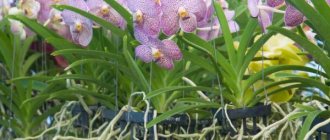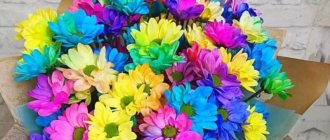Drawing a diagram of a home flower
Let's start with a small flower pot.
Then take a tree branch, the size of which is 3-5 times higher than the pot (Fig. 1). It is better if this branch is thick, old and easily broken. Such a branch can be selected from dead wood or old dead tree branches. Break off all the small branches and leave only one core of a branch approximately the same as in Fig. 1. Fill a pot with earth or sand and stick a branch into it. Place the pot with the branch on the windowsill or on the table. If the pot is on the table, then you need to make a light background (paper or sheet) so that the pot and branch stand out well against the light background. This will be our nature. Figure 1 — Branch for constructing a drawing diagram
Next, you need to choose a place for the chair on which you will sit and work. It is best to position yourself 3 m from the object you took. Sit in a position that is comfortable for you and that the paper you are going to draw on is well lit. How to place a folder, hold a pencil or charcoal has already been discussed enough in the article about.
Take a closer look at the so-called “flower in a pot” and estimate by eye how you can arrange the future drawing on paper. The entire pattern of the pot and branch should occupy at least 4/5 of the height of the leaf. The drawing should be in the middle, and there should be some space (margins) at the top, bottom and sides.
To find a suitable place for your future drawing, draw a light vertical line on which, by eye, mark where the bottom of the pot and the top of the branch will be (take the pot and branch as a single whole). Of course, this may not be possible right away, but you will make the necessary corrections, and thus the line with the top and bottom marks will determine for you the location of the future drawing.
Now estimate by eye: what part of this line the pot occupies (the height of the pot). Beginners usually greatly exaggerate the size of the pot because it is massive, heavy and has a very different character from the branch. But we have the opportunity to check the size of the pot and branch by measuring with a pencil. After measuring the height of the pot and comparing it with the height of the branch, we make corrections by eye (Fig. 2.1). The check, especially at first, needs to be done more than once. This first operation, like the first exercise with the circuit, is the most difficult, but at the same time the most decisive. If this first task is solved correctly, then it will be easier to work further. If a mistake was made, it will inevitably lead to a number of further mistakes.
Figure 2 - Stages of drawing an indoor flower in a pot
The next task is to build a diagram of the pot and branch
.
You determine by eye the width of the pot at the top using the height of the pot. First you need to determine which is greater: the height of the pot or the width, and then how much greater, and mark the width of the pot in your drawing. Having noted, measure with a pencil and make corrections. Use the same exact method to find the width of the base of the pot. As a result, you get a diagram like in Figure 2.2. Having checked the diagram of the pot, we move on to building a branch
.
A branch has a main trunk and branches. The trunk is not straight, but you will determine its shape a little later. In this case, again, by eye, try to find the place where the main branch comes from, and roughly (simplified) outline it. Check first by eye, and then by measuring with a pencil the dimensions of the trunk to the branch, then the dimensions of the trunk from the branch to the top of the trunk and, finally, the dimensions of the depicted branch. All this is by comparison. You do the same with the second and the remaining largest branches (Fig. 2.3).
Having outlined the diagram of the pot and the branch, once again check the ratio of the height of the pot to the height of the branch, as well as the width of the pot to the side branches, checking that you outline the main bends of the trunk and the largest branches. If the diagram is correct, then 90% of the work has already been done. Moreover, the most difficult and most important thing has been done (Fig. 2.4). Next, if you find it necessary, outline the most necessary details.
The work, as you can see, is difficult and painstaking, requiring great perseverance. You will get tired of this work more than once. Having finished the diagram, you need to put the drawing aside, not look at it for a while, and then, putting it in place, look at it with rested eyes.
This exercise is more convenient and easier to perform not with a pencil, but with charcoal.
Blooming prickly genius
Cactus is a very beautiful plant. When it blooms, it produces beautiful bright flowers. Now we will learn how to draw a thorny succulent at the moment of its flowering.
- It is recommended to start drawing with a pot. First, let's draw a horizontal narrowed sphere.
- Next, you should draw two short narrowed lines from the sphere down and connect them together. The rim of the pot is ready.
- From the rim we also draw down two narrowed lines and connect them together. The pot is ready. Now let's proceed directly to the plant.
- Draw a big circle. It should come out from the edge of the pot, the lower third of the circle will remain “sit” in the pot, the remaining two thirds will fill the space above it.
- The next step is to use an eraser to erase the back surface of the pot, located in the circle, and the lower hemisphere of the circle, which overlaps the pot.
- Let's make grooves on the stem. It is necessary to draw 4-5 lines from the top of the succulent to the beginning of the rim, repeating the direction of its outline.
- Let's move on to drawing the flower. At the very top of the succulent you need to draw a small horizontal circle - the core of the future flower. 5 petals should extend from it, forming the first tier, and the next 5, forming the second tier.
- We decorate the prickly genius with expressive thorns. To do this, you need to draw asterisk shapes from three intersecting segments on its furrows. It is better to make some spines large, and some small.
- We make sketches in those places where the shadow will lie. It's easy. In the shadow areas, the color segment should be a tone and a half darker than the main one. The horizontal shadow will run along the entire lower edge of the rim; the shadow will fall on the plant along the central vertical furrow and along the furrow located to the left.
- Recommendations for coloring. The flowerpot can be made in a brown shade; the shadow line along the lower edge of the edge should be dark brown. A green tint is perfect for a succulent; it is recommended to color the vertical shadow line along the central and left extreme furrows with a dark green pencil. The flower should catch the eye. For the core of the flower, it is recommended to use yellow; for the petals, you can choose any bright shades - pink, crimson, purple, lilac.
Parts of plants for children: diagrams and pictures
The most beautiful flowers in the world: 30 photos with names
Plants play an important role in our lives. We know indoor and wild plants. Indoor ones grow on our windowsills in pots, and many children are very familiar with them.
Medicinal plants are also of great importance: many medicines are made from them. When telling children about medicinal plants, do not forget to mention plantain. Children should definitely know what a plantain looks like. The kids run a lot outside and often fall, scraping their knees. Plantain can be the best medicine for wounds and scratches if you apply a clean leaf to the wound in time. Plantain is our reliable friend on hikes, when there may not be medicine at hand. The juice of this plant is often infused with alcohol and drunk for colds. So every child should know the plantain by sight.
What's the best way to introduce children to plants? Images, coloring pages, riddles and poems on our website will help with this.
Materials and tools
Professionals use a simple pencil to create realistic paintings. The advantage of redrawing live plants is that you can carefully view the detail of the object. To draw flowers in a pot, like the masters, you will need the following equipment:
- Pencils of different hardness, ranging from light graphites to dark ones.
- Pen with black paste.
- A nag for erasing unnecessary lines.
- Material for rubbing out hatching.
- Landscape sheet with high density A4 or A5.
- Ruler.
You might be interested in: How to draw cartoon eyes? Step-by-step instruction
For a beginner to draw flowers, it is better to choose a simple object to redraw.
Pencil drawing step by step “Flowers in a vase” for children and adults, master class with photos
The most beautiful and unusual flowers, next to which roses are just wild dandelions
Flowers in a vase is another version of a step-by-step pencil drawing, which both adults and children can master in our master class. This pencil drawing “Flowers in a Vase” for children and adults is perfect for decorating a holiday card or as an independent picture.
Instructions on how to draw flowers in a vase with a pencil step by step for children and adults
- A jug will serve as a flower vase, the blank of which we draw in the form of a tall rectangle. We make blanks for future flowers in the form of ovals and lines.
- At the base of the jug we draw an oval to make the vase more voluminous. We also designate the centers of flowers and leaves.
- Add a handle and spout to the jug. Draw the petals of the buds in more detail. In our case, the bouquet will consist of sunflowers and daisies. We also draw the stems and leaves of the flowers in more detail.
- We move on to the design of sepals and cores.
- We draw all the contours and details more clearly. Use an eraser to remove the excess. If desired, color the drawing with colored pencils.
How to draw a picture “Flower in a pot” - lesson for beginners, video
A beautiful drawing of a flower, made with a pencil or paints, can decorate any postcard or children's craft. However, not only drawn individual flowers and bouquets in a vase, but also a drawing of a decorative flower in a pot from the video tutorial for beginners below can be an excellent decoration, no worse than a bell, for a postcard on March 8th. How to draw a picture “Flower in a pot” (lesson for beginners with video), see below.
Pencil drawings for beginners: flowers is a collection of simple and clear step-by-step drawing lessons with which anyone can quickly and easily learn to draw beautiful flowers.
Every person is not alien to the feeling of beauty, and for many it is an expression of this feeling. Images created by a skillful hand using a simple pencil evoke admiration and a desire to create something similar, to throw out your sense of beauty on paper.
If you feel the need to create something beautiful, but still have a rather weak idea of how to draw with a pencil, then this article is what you need. Here we have collected useful step-by-step pencil drawing lessons for beginners, dedicated to the eternal theme of “Flowers”. By following these simple diagrams, you can learn how to draw beautiful flowers with a pencil on your own and delight your friends and family with your new talents.
Is it possible to learn how to draw with a pencil on your own?
According to expert opinion, anyone can learn to draw with a pencil, regardless of their predisposition and age.
Let's start getting acquainted with the wonderful world of drawing with a list of materials and tools that you will need in your hobby:
- a sheet of white paper, any format;
- eraser;
- simple pencils.
How to draw with a pencil: where to start
You need to get better at drawing and gain experience, starting with the simplest pencil sketches. Pencil drawings for beginners: flowers in this case are one hundred percent suitable, as they allow:
- Make the first meaningful sketch and the simplest composition of the drawing,
- Define contours, draw details and apply shadows,
- If desired, color the drawing to make it more realistic.
Having prepared the tools and materials for drawing and decided on the theme of our composition, we can move on. We bring to your attention a selection of step-by-step flower drawing lessons for beginners. Choose the most interesting ones in your opinion and start practicing. At first, you can simply redraw lines and shapes according to photographs. Once you master the simple techniques presented in the photo master classes, you will be able to modify them, creating your own style of drawing flowers with a pencil.
How to draw roses with a pencil:
A cute flower drawing for the holiday of March 8 can be drawn either with paints or with a pencil. But complex drawings with the application of shadows and shading of shades are best left to students at school. But for kids in kindergarten, simple images that do not require special artist skills are more suitable. Cool examples of pictures for beginners are also ideal for this task. Having made bright drawings with roses, bells and other flowers, you can give them to your mother or grandmother on Women's Day. You can add a beautiful vase or small pot to such a picture. All considered composition options can be created using the proposed step-by-step master classes with photos and videos.
Blooming prickly genius
Cactus is a very beautiful plant. When it blooms, it produces beautiful bright flowers. Now we will learn how to draw a thorny succulent at the moment of its flowering.
- It is recommended to start drawing with a pot. First, let's draw a horizontal narrowed sphere.
- Next, you should draw two short narrowed lines from the sphere down and connect them together. The rim of the pot is ready.
- From the rim we also draw down two narrowed lines and connect them together. The pot is ready. Now let's proceed directly to the plant.
- Draw a big circle. It should come out from the edge of the pot, the lower third of the circle will remain “sit” in the pot, the remaining two thirds will fill the space above it.
- The next step is to use an eraser to erase the back surface of the pot, located in the circle, and the lower hemisphere of the circle, which overlaps the pot.
- Let's make grooves on the stem. It is necessary to draw 4-5 lines from the top of the succulent to the beginning of the rim, repeating the direction of its outline.
- Let's move on to drawing the flower. At the very top of the succulent you need to draw a small horizontal circle - the core of the future flower. 5 petals should extend from it, forming the first tier, and the next 5, forming the second tier.
- We decorate the prickly genius with expressive thorns. To do this, you need to draw asterisk shapes from three intersecting segments on its furrows. It is better to make some spines large, and some small.
- We make sketches in those places where the shadow will lie. It's easy. In the shadow areas, the color segment should be a tone and a half darker than the main one. The horizontal shadow will run along the entire lower edge of the rim; the shadow will fall on the plant along the central vertical furrow and along the furrow located to the left.
Recommendations for coloring. The flowerpot can be made in a brown shade; the shadow line along the lower edge of the edge should be dark brown. A green tint is perfect for a succulent; it is recommended to color the vertical shadow line along the central and left extreme furrows with a dark green pencil.
The flower should catch the eye. For the core of the flower, it is recommended to use yellow; for the petals, you can choose any bright shades - pink, crimson, purple, lilac.
Ficus drawing - step by step lesson 1
How to draw a lily with a pencil step by step
It is clear that we will learn to draw a ficus with the goal of, in principle, mastering the approach to depicting a tree with foliage. Let's start with a pencil sketch:
The plant is not yet very large - the trunk is relatively thin and has few branches. But there are already a lot of leaves - they are large, oval and located at different angles. Yes, yes, children, unless specifically warned, will simply draw ovals evenly hung on the branches, but we understand that in reality you cannot arrange leaves in a line. But there is still a certain pattern - the leaves are all directed outward from the trunk:
The width of the oval depends on the angle at which the sheet plate is turned towards the viewer:
Well, this is how the ficus drawing turned out. Let's color the leaves - they are shiny, dark green, the midrib is light and clearly stands out:
Let’s imagine that the ficus grows in its own India and we won’t paint on the pot or tub. And I’ll tell you: it’s not a good idea to teach children to draw all the flowers in a row in pots or vases - then they won’t be able to adapt and depict “free” plants.
And one more lesson - shorter.
Sketch:
This ficus is more densely leafed, the trunk and branches are practically invisible and the leaves are arranged more interestingly, and, by the way, pay attention - the younger leaves are smaller than those that have already fully developed
Let's color the picture with ficus. Let’s mark the highlights on the glossy leaves; this will make it possible to fragment the picture so that the crown does not appear as a dark green monolith.
Pencil drawings for beginners: flowers is a collection of simple and clear step-by-step drawing lessons with which anyone can quickly and easily learn to draw beautiful flowers.
Every person is not alien to the feeling of beauty, and for many it is an expression of this feeling. Images created by a skillful hand using a simple pencil evoke admiration and a desire to create something similar, to throw out your sense of beauty on paper.
If you feel the need to create something beautiful, but still have a rather weak idea of how to draw with a pencil, then this article is what you need. Here we have collected useful step-by-step pencil drawing lessons for beginners, dedicated to the eternal theme of “Flowers”. By following these simple diagrams, you can learn how to draw beautiful flowers with a pencil on your own and delight your friends and family with your new talents.
Is it possible to learn how to draw with a pencil on your own?
According to expert opinion, anyone can learn to draw with a pencil, regardless of their predisposition and age.
Let's start getting acquainted with the wonderful world of drawing with a list of materials and tools that you will need in your hobby:
- a sheet of white paper, any format;
- eraser;
- simple pencils.
How to draw with a pencil: where to start
You need to get better at drawing and gain experience, starting with the simplest pencil sketches. Pencil drawings for beginners: flowers in this case are one hundred percent suitable, as they allow:
- Make the first meaningful sketch and the simplest composition of the drawing,
- Define contours, draw details and apply shadows,
- If desired, color the drawing to make it more realistic.
Having prepared the tools and materials for drawing and decided on the theme of our composition, we can move on. We bring to your attention a selection of step-by-step flower drawing lessons for beginners. Choose the most interesting ones in your opinion and start practicing. At first, you can simply redraw lines and shapes according to photographs. Once you master the simple techniques presented in the photo master classes, you will be able to modify them, creating your own style of drawing flowers with a pencil.
How to draw roses with a pencil:
How to draw a cactus in a flower pot in the desert.
Low, tall, green, yellow, with or without spines, crowned with a beautiful flower or not blooming - all this is about cacti. The cute plants growing in flower pots on our windowsills remind us of tropical lands where summer lasts forever. Guests of arid deserts sometimes delight their hosts with their exotic appearance and beautiful flowers, and deservedly enjoy all the privileges of pets.
A houseplant can be so interesting to children that they want to draw a picture of it. Let's try to figure out together how to draw a cactus. The article contains step-by-step descriptions of cactus drawings both in our usual form - in a ceramic pot, and in the wild, where they grow to incredible sizes.
Cactus in a pot
Previously, these plants lived only in the desert among the burning bright sun and hot sands. Today these flowers live in almost every apartment and are common indoor plants.
Drawing this prickly guest in a pot is quite simple and does not require any artistic skills. It will be enough to open our lesson, carefully focus on the process, prepare paper and pencils.
- We start the drawing with a figure. You need to draw an unfinished oval extended upward, this will be the stem.
- Add a small shoot from the left side.
- Add another shoot from the right side, slightly lower than the left one, but both of them should be approximately the same height.
- At the bottom we draw a horizontal narrow semicircle. The flower should come out of this semicircle, which will serve as the edge of the pot. The upper part of the oval should extend beyond the stem, so where they intersect, you need to erase the extra line with an eraser.
- From the oval on both sides, you need to draw two segments down and connect them together. The flower pot is ready.
- All that remains is to color the drawing. The flower is painted over with a green pencil. Using a dark green marker, draw vertical straight lines along the stem, parallel to the sides of the succulent. Repeat this approach step by step for the two lateral processes. Paint the pot with bright colors, for example red, or add an interesting pattern or geometric design.
Reflection of a flower on the surface
I duplicate all the layers with the flower, merge them, flip them vertically and move them under the group with the pot. I deform (Ctrl+T) the reflected layer so that the extreme points of the bottom edge coincide. I add a mask, which I fill with a linear gradient with a transition from black to transparent so that only the bottom and side of the pot are visible in the reflection.
https://www.bolshoyvopros.ru/questions/881659-kak-narisovat-cvetok-v-gorshke-poetapno.htmlhttps://kakinfo.ru/iskusstvo/5701-kak-narisovat-cvety-v-gorshke-karandashom- s-natury-pravilnohttps://www.maam.ru/detskijsad/nod-hudozhestveno-yesteticheskoe-razvitie-risovanie-na-temu-nashi-komnatnye-rastenija.htmlhttps://domenart-blog.ru/kategorii/dizajn/ texnicheskij-dizajn/107-risuem-czvetok-v-gorshke
Decor of flower pots: creativity for the garden
Filled with colorful flowers, the garden is the perfect place to relax. Thanks to pots and accessories, you can easily create a spectacular composition that will catch the eye of all passersby. Metal flower boxes in bright, rich colors will be a wonderful decoration in a modern style, and hand-painted ceramic pots are ideal for a Provençal-style design
Are you interested in a large hanging box or individual flower pots attached to a balustrade? No matter what you choose, in each option the garden will bloom with a riot of colors. Mix different colors and materials, experiment freely and create unique decorations
Hollow bricks and stone slabs
The first idea is to use regular building blocks. Fill the container with soil and plant flowers in it. The second idea is to use paving slabs. 5 pieces are enough to make a pot. You need to use a good construction adhesive.
GCD for drawing on the topic “Our indoor plants”
Yulia Titova
GCD for drawing on the topic “Our indoor plants”
GCD “Artistic and aesthetic development (Drawing)” on the topic “
Our indoor plants
"(drawing from life)
Program content: - Teach children to convey in a drawing the characteristic features of a plant group (structure and direction of the stem, leaves, shape of a flower pot;
- develop the ability to see tonal relationships (light and dark places) and convey them in the drawing by increasing or decreasing the pressure on the pencil;
- develop small hand movements (when depicting small parts of a plant);
- to develop the ability to regulate the drawing movement of force, to successfully place it on the sheet.
Materials: indoor plant (Geranium - Pelargonium, Peperomia, Crassula (Crassula or Money tree, Chlorophytum, Papyrus papyrus (Swampweed), wax crayons, felt-tip pens, colored pencils, albums, pencil, eraser, sample drawings on the board.
Methodology: Examine indoor plants, clarify their names, method of care (watering, sun); compare plants with each other, note the structure and color characteristics of each plant.
GCD move
V. -Good afternoon, guys. (Children say hello). Today we will draw our indoor plants. You often watch them, look after them and know their names. Yes, flowers also have names - these are their names.
V.: Guys, why do we need plants? (if children answer incompletely or incorrectly, the teacher tells them)
V.: Plants absorb harmful substances, create comfort in the home and in the group, and the green color also has a pleasant effect on the eyes, because looking at the green color the eyes relax. Another plant is a “Home Doctor”, they can be used for treatment, for example, Aloe, Colonchoe (for the runny nose, and aloe also treats wounds)
Today we will draw them.
(the teacher puts flowers in front of the children)
IN
: Guys, please note that all the flowers in our group are different
There are flowers that look like palm trees - this is Papyrus indoors
, this plant has a long stem and on the top of the head, like a “palm”, long, thin leaves open in the form of a “star”, and there is a plant whose leaves are plump and round - this is Crassula or
Crassula,
this flower is also popularly called “
Money tree”
“As the flower grows, the stem eventually becomes covered with a crust like a tree and the leaves look like coins.
Here is another interesting plant - Peperomia, this plant has round, smooth leaves and look at the color they are the darkest - Dark green
Pay attention to this when you draw it. We have Geranium in our group
V.: Guys, what’s special about this flower? (yes, that’s right, it has curly leaves, they are rough to the touch and when you touch the plant it smells. Geranium is scientifically called Pelargonium
.
V.: Guys, choose any of the plants and draw it. Draw on the entire sheet. (Children do their own drawing of their choice)
Our works
V.: We got very beautiful plants.
Literature: Komarova T. S. Visual activities in kindergarten: Preparatory group for school. - M.: MOSAIC-SYNTHESIS, 2016. - 112 p. (pp. 43-43)
Games on the lexical topic “Indoor plants” PALMA Goal. Tighten and relax alternately the arm muscles in the hands, elbows and shoulders. Progress of the game. “A big, big palm tree has grown”: right.
Summary of an open lesson in a secondary physiological group on the topic “Indoor Plants” Goal: To form a comprehensive understanding of indoor plants, their benefits and structure. Objectives: Learn to distinguish indoor plants by...
Project “Indoor Plants” Environmental project in the middle group “Indoor Plants” Group “Snail” Educator: Kulikova N, R. Theme: Houseplants are ours.
Project “Indoor Plants” Introduction Project theme: “Indoor Plants” Relevance The use of indoor plants for the formation of environmental concepts is advisable.
Lesson summary “Indoor plants are our friends” Topic: “Indoor plants are our friends” Purpose. To consolidate children's ideas about indoor plants (impatiens, Chinese roses) and them.
Drawing lesson “Indoor plants” PLANTS NEAR US. DRAWING FROM LIFE “HOUSEPLANT” Integration of educational areas: “Cognition”, “Communication”, “Health”.
Prickly baby
- These plants were not always so large and mature. Each prickly representative was once a baby. Let's draw such a baby.
- We start the drawing by drawing the flower pots. To do this, you need to draw a line slightly curved upward, to the left and right of it we draw down two small segments, connecting them together. The result was the edge of the future pot.
- From the edge we lower the two side features and connect them to each other at the bottom. The flower pot is ready.
- A long oval extends upward from the edge - this will be the stem of the plant. Let's draw 4 vertical grooves along the sides of the trunk, each of them will come from the top of the succulent and end at the edge of the flowerpot.
- Let's add some eyes to the baby. Two even circles will serve as eyes. In each eye you need to draw a small circle-pupil and to the left of the pupil draw a larger circle that will serve as a highlight. The pupil circle and the highlight circle should remain unpainted and white. In each eye below you need to draw an eyelid - for this you need to draw a quarter of a circle and divide the resulting part into 4 sections. The eyelids are painted over with the same color as the entire succulent. The eyes, except for the pupil, highlight and eyelid, are painted over with a black marker. Good bright black pigment. In the center of the stem, just below the eyes, draw an arched smile.
- On both sides of the plant add small ovals coming out of its shape. In the ovals on the sides, draw two grooves from the top to the base.
- Add short spines along the entire contour of the stem.
- The entire plant is painted over with a green felt-tip pen. Areas running along the furrows and the general contour are highlighted in dark green. The flower pot can be painted over with orange pigment. On the left side of the flowerpot, leave a vertical white stripe untouched - a light highlight on the surface of the flowerpot.
- Trace all the contours with a black helium pen, liner or felt-tip pen. The picture is ready.
Practical part of the lesson
After a brief introduction to the theory, students should begin drawing. The plant is a great way to learn how to draw long straight lines without a ruler, mix different shades of green, adding yellow, blue or brown to the paint, layouts on a sheet (the drawing should be large enough, located in the center).
Suitable techniques for drawing in the senior group:
pointillism - drawing with dots, suitable for watercolors; “wet on wet” watercolor is suitable for painting large areas (background, leaves, pot); gouache, but you need to explain how to mix colors to convey shadow and light; colour pencils
Attention should be paid to the contour beyond which you must not go.
Example of step-by-step drawing of flowers
To create a creative atmosphere, you can turn on music. It should be a calm melody without words so that it does not distract the children. It is worth considering that a song that is too cheerful and fast will undermine the calm.
Important! The musical accompaniment should not be too loud so as not to cause discomfort. How should drawing “Indoor Plants” proceed step by step (senior group of kindergarten):
How should drawing “Indoor Plants” proceed step by step (senior group of kindergarten):
- Organize your workplace.
- Make a composition on a sheet of paper. Mark the location of the inflorescence in a circle in the center, the stems with lines, and the leaves with ovals.
- Draw an outline with a simple pencil.
- Explain the features of the technique chosen for drawing.
- Paint over in stages: first the background, then the light areas of the flower, then the dark ones.
- Dry the drawing.
- Use a brush with a minimum of water to draw details (veins in leaves, highlights).
Works of the children from the senior group
Learn to draw a flowerpot with daisies step by step
When drawing flowers, you can always give free rein to your imagination and creativity. You can use different techniques, materials, implement any ideas and play with the difference in colors. On our website we already have a sufficient number of creative works that depict bouquets, a drawing of a lily of the valley, a rose or a dandelion, a vase, etc. In this drawing lesson we suggest drawing a flowerpot, or rather, indoor daisies in a pot. The stages of work are not at all difficult. Follow the instructions carefully and you will succeed.
Auxiliary lines
We recommend drawing two even cross lines in the center of the sheet. Use a ruler for this. Starting from them, it will be much easier to draw a picture.
Top of the pot
Indoor plants are usually planted in beautiful clay pots. They have a peculiar shape. The upper part protrudes slightly and differs in size.
Bottom of the pot
We depict it in the form of a trapezoid. It is enough to add two straight lines on both sides. And draw a semicircular bottom.
Flowers
For example, we chose to draw daisies in a pot. Carefully repeat the details as in the picture. If you have any difficulties, you can look at more detailed instructions on how to draw a daisy step by step.
Erase the lines that intersect.
Using the same principle, we depict the following flower heads. We start with the simplest elements – the middle.
Add the petals, first on one side.
Then - on the other.
Erase the lines
We will no longer need auxiliary parts. It's time to get rid of them. Erase carefully with an eraser.
Greenery
Like most flowers, it has green leaves. We draw them in the form of thin, sharp shapes that resemble tongues.
Color it
To make the drawing play with different colors and look more interesting and impressive, it needs to be painted. You can offer this to your child as a coloring book or do it together. The choice of color is at your discretion.
Collage
Choose the appropriate color and draw on the site
If you like to color online, we suggest using online coloring of flowers in a pot. Your child will definitely love this activity!
Choose how you want to paint.
Video for the material
If you see an error, please select a piece of text and click
Did you like the instructions?
More instructions on this topic:
How to draw a geranium flower in a pot: work progress
1. First of all, I do a pencil drawing. Unfortunately, it was not possible to capture it in the photo.
2. I start working in watercolors with the most important thing - geranium flowers.
I prescribe them with the lightest shade of pink.
At the same time, I give the pink shade either warmer or cooler. To do this, I introduce a more reddish one into the spot of light cold pink.
3. I write out all the flowers this way, and then move on to the leaves.
I also prescribe them in the lightest and warmest green, with a slight tint of shade:
Please note that I paint ALL the leaves with a light shade, without distinguishing whether they are in the light or in the shade.
4. I do the same with the potty.
I paint it in different shades of pale orange and pink:
More flower usefulness:
5. Now I’m painting the floor tiles near the pot.
To do this, I first lay strokes of the same color at a distance. And then, as they dry, there is another next to them and partially on them.
6. I do the same with the pattern of the stonework, which I want to remain “in focus”, without blurring:
To make it, I first moisten the paper where I will apply the paint, and then apply the desired colors to the wet surface.
Here I also want to talk about how to paint a falling shadow.
Its main color is indigo. But inside I'm adding a lighter shade of terracotta from the pot. This allows you to create transparency of the falling shadow and give it a connection with the pot.
This way I solve all the remaining pieces of the background.
How to depict the abundance of small lilac flowers that make up a whole lacy cloud of inflorescences?
- a whole bouquet of lilacs of different shades framed by a background
- glass vase and lace napkin!
8. During this time, the flower itself has dried, you can apply a second layer of watercolor.
I paint shadow areas on the greenery.
To do this, I take a darker tone of green, and along the edges of the shadows I additionally pour indigo into the stain.
How to draw Aloe. I personally like Agave - But Aloe vera is more healing and therefore more popular - people want to know how to draw aloe vera. Moreover, people want to learn how to draw a flower not in nature, but in a pot. (Or rather, I believe, the goal is to teach children to perceive flowers as domesticated, isolated from wild nature and subordinate to the crown of creation - MAN.) One way or another, the concept of “flower” is almost inextricable associated with the words “pot” or “vase”. Okay, let's draw a flower-pot combination on the Aloe vera theme.
We find an expressive picture on the Internet and draw it as similar as possible.
The flower itself looks like a bunch of long, fleshy leaves pointed at the end. We'll get to that later. Let's draw a pot first. In this case it is very simple - an inverted truncated cone.
You will need to draw construction lines - the axis of symmetry, the middle lines of the bottom and inlet. And the pot itself will need to be “built”, that is, actually draw a symmetrical figure. The two ovals should turn out to be ovals.
After making sure that my constructions were of sufficient quality, I circled the drawing:
At this point we will leave drawing the pot for now and turn to the flower. We will draw from the bottom up, sequentially increasing the leaves:
The leaves are not conical, they are flattened and have non-sharp teeth along the edges.
The leaves are stem-embracing. I didn’t want to use such scientific terminology, but this word very accurately describes how the leaf is structured: there is no usual petiole, on the contrary, the leaf expands at the base and covers the stem on both sides.
So we made a linear drawing - let's call it “Aloe Vera Coloring Book”. And we'll color it. First, I’ll paint the pot, color it correctly, so as to emphasize the volume:
How to draw a palm tree
Master Class. Lessons for drawing indoor flowers "Palm"
Purpose of the Task:
Educational: to cultivate the ability to emotionally and value-consciously perceive works of fine art, to express one’s attitude to the surrounding world in creative works, to develop the ability to work and create; nurturing love for nature; The houseplant we will draw is Chrysalidocarpus, a highly branched reed palm. The most common (Chrysalidocarpus yellowish). It has long and thin feathery leaves that are yellowish-green in color. The cuttings are covered with black scales. Grows up to 2.5 m.
Materials:
This article will show and tell you how to draw a cactus. Any person can draw a flower; to do this, it is enough to break the drawing into simple shapes: circle, straight line, curve, cylinder, ellipse, etc. Using this approach, it will be quite easy to depict this exotic plant.
Positive example of a pot
A positive example will tell us how to draw a flower in a pot with a pencil, but it will be an unusual drawing. This time the plant will have a cheerful face, thereby we will revive it! This drawing is very bright, so we will definitely need colored markers to draw it!
Let's start by drawing the flower itself on a thin stem. You don't have to follow the instructions exactly. You can easily come up with any other shape and size.
We are working on the pot. As is usually the case, its upper part is much wider than the lower. After we draw the contours, we need to divide it into even parts with horizontal stripes.
Draw big eyes and a smiling mouth, thereby making the drawing cute! If you don't want to do this, then of course you don't have to paint on it.
Now take colored markers and color. Take a look at the pot itself. Since its shape is round, it must have chiaroscuro and we have displayed it in this example. Some places turned out lighter, and some darker, pay attention to this.
Source
How to draw a flower in a pot, step by step?
How to draw a flower in a pot, step by step with a pencil or paints?
Drawing a flower in a pot:
First stage. First, we determine the size of the flower, marking them with simple lines. And then we’ll determine the location of the flower by drawing two lines.
Second phase. Our pot is on a saucer, so we draw its thickness. We also draw a window.
Third stage. We draw the shape of the stand on which the pot stands, as well as the top part of the pot. And we determine the total mass of the flower.
Fourth stage. We draw lines that will show the thickness of the window frame. We outline the position of the flower branches.
Fifth stage. We draw the leaves of the flower, as well as the details of the pot.
Sixth stage. We continue to draw the details of the pot.
Seventh stage. We use shading and draw shadows:
There is also a step-by-step drawing of a flower in a pot. Let's start drawing with a pot
Drawing a flower in a pot is not at all difficult; if you follow the step-by-step steps, you can draw it in a few minutes.
For example, to draw a chamomile like this in a pot, you need to take a landscape sheet, a simple pencil and colored pencils.
We look at the detailed instructions and repeat.
Next, we color it and get a very nice picture.
You can draw a cactus in a pot in approximately the same way; it’s not difficult to do, but it turns out very beautiful.
Both schoolchildren and preschoolers can cope with such a drawing with the help of their mother.
Well, it depends on what kind of flower you want to draw.
The main thing is to draw a flower, and finishing the pot is as easy as shelling pears
How to draw flowers step by step
Drawing flowers is always a pleasure, especially if such a drawing is made as a gift to a loved one.
It is best to start drawing from life, and flowers in a pot are ideally suited for this purpose, since you can return to the drawing after a certain period of time - the flowers will not fade like in a vase.
First, draw the overall dimensions of the pot along with flowers and simple geometric shapes, then outline the main elements of the drawing within your overall markings.
Only then begin detailed work; only this sequence will protect you from serious mistakes in drawing.
After finishing working on the pencil base of the drawing, start working with color; absolutely any materials will do, be it graphic pencils and crayons or watercolors or gouache.
If you like to draw, you can try your hand at drawing a heart or a space theme.
Drawing a flower in a pot is perhaps one of the easiest to draw with a pencil on paper. Even primary school students can handle it. Of course, there are technically complex flowers with light and shadows and so on, but basically all MKs are simple. I suggest one of these.
First, we divide the sheet into lines to make it easier to draw the pot along them. We start from the top first, which is wider than the main part of the pot. Next we draw the pot itself. Well, we will “plant” daisies in it. It’s not difficult to draw three of them in turn; we finish with leaves. Once you have drawn, erase the auxiliary lines and color them.
Below is a drawing for those who need a more complex technique with shading and shadows. It is more realistic than I gave in MK above. Everything is as usual - from auxiliary lines, contours, and then finer details, shading, etc.
Cactus in a pot
Previously, these plants lived only in the desert among the burning bright sun and hot sands. Today these flowers live in almost every apartment and are common indoor plants. Drawing this prickly guest in a pot is quite simple and does not require any artistic skills. It will be enough to open our lesson, carefully focus on the process, prepare paper and pencils.
- We start the drawing with a figure. You need to draw an unfinished oval extended upward, this will be the stem.
- Add a small shoot from the left side.
- Add another shoot from the right side, slightly lower than the left one, but both of them should be approximately the same height.
- At the bottom we draw a horizontal narrow semicircle. The flower should come out of this semicircle, which will serve as the edge of the pot. The upper part of the oval should extend beyond the stem, so where they intersect, you need to erase the extra line with an eraser.
- From the oval on both sides, you need to draw two segments down and connect them together. The flower pot is ready.
- All that remains is to color the drawing. The flower is painted over with a green pencil. Using a dark green marker, draw vertical straight lines along the stem, parallel to the sides of the succulent. Repeat this approach step by step for the two lateral processes. Paint the pot with bright colors, for example red, or add an interesting pattern or geometric design.
Beautiful drawing of a flower “Forest bell” for beginners, step-by-step master class with photos
The forest bell is not just a beautiful flower, but also an excellent start for novice artists, including children. Learn how to draw a beautiful drawing of the “Forest Bell” flower for beginners from the step-by-step master class with the photo below.
Instructions for beginners on how to draw a drawing of a flower “Forest bell”
- At the first stage, we mark the future flower: draw a long vertical line and a short horizontal line below. On top we draw two blanks for bell flowers in the form of parallel ovals.
- Along the length of the trunk we draw smaller ovals, which will become smaller buds. Add volume to the leaf.
- Inside the large ovals we draw the teeth of the petals. We also decorate the tops of small ovals with teeth.
- We draw each bud and stem in more detail.
- Add leaves and draw the sepals of each bell bud.
- We add dimension to the flowers by drawing the petals and cores.
- We trace the bell along the contour and remove the extra strokes with an eraser. Ready!
Prickly baby
These plants were not always so large and mature. Each prickly representative was once a baby. Let's draw such a baby.
- We start the drawing by drawing the flower pots. To do this, you need to draw a line slightly curved upward, to the left and right of it we draw down two small segments, connecting them together. The result was the edge of the future pot.
- From the edge we lower the two side features and connect them to each other at the bottom. The flower pot is ready.
- A long oval extends upward from the edge - this will be the stem of the plant. Let's draw 4 vertical grooves along the sides of the trunk, each of them will come from the top of the succulent and end at the edge of the flowerpot.
- Let's add some eyes to the baby. Two even circles will serve as eyes. In each eye you need to draw a small circle-pupil and to the left of the pupil draw a larger circle that will serve as a highlight. The pupil circle and the highlight circle should remain unpainted and white. In each eye below you need to draw an eyelid - for this you need to draw a quarter of a circle and divide the resulting part into 4 sections. The eyelids are painted over with the same color as the entire succulent. The eyes, except for the pupil, highlight and eyelid, are painted over with a black marker. Good bright black pigment. In the center of the stem, just below the eyes, draw an arched smile.
- On both sides of the plant add small ovals coming out of its shape. In the ovals on the sides, draw two grooves from the top to the base.
- Add short spines along the entire contour of the stem.
- The entire plant is painted over with a green felt-tip pen. Areas running along the furrows and the general contour are highlighted in dark green. The flower pot can be painted over with orange pigment. On the left side of the flowerpot, leave a vertical white stripe untouched - a light highlight on the surface of the flowerpot.
- Trace all the contours with a black helium pen, liner or felt-tip pen. The picture is ready.
Putting the potty in order
1. First, I erase and correct the bottom: I create an elliptical selection at the bottom of the pot.
I select the “Brush” tool (B) with 100% opacity and hard edges, with the “Brush” tool active, use an eyedropper (or click while holding Alt on a sample of the desired color) to select a color from the pot, and paint over the hole at the bottom of the pot. In principle, at this stage the color is not important, it can even be black, it’s just more convenient for me when the colors are closer to the main gamut. I invert the selection (Shift+Ctrl+I) and use a hard eraser (E) to erase the edges of the pot that are coming out for the selection area. I remove the selection area (Ctrl+D).
2. I work on the top of the pot in the same way: I create an elliptical selection, along the contour as close as possible to the top edge of the pot, fill in where there is not enough fill and erase the excess. I invert the selection again (Shift+Ctrl+I) and copy the selected area to a new layer (Ctrl+J). I name the new layer “Top edge of the pot” and duplicate it again. For the “Top edge of the pot” layer, using an elliptical selection, I cut out the center so that only the horizontal border remains, and rename the duplicate to “Earth”, drag it in the layers panel under the “Top edge” layer and erase the pot with an eraser, leaving only the soil.
3. Select the side part of the top edge and copy it to a new layer, placing it under the “Top edge of the pot” layer and calling it “Top edge side”.
The difference between a flowerpot and a pot
Many people believe that a flowerpot and a pot are the same thing. In fact, these are two different concepts. A flowerpot is a decorative container, usually decorated in every possible way. And you don’t even have to put soil in it - you can simply place a simple pot of suitable size with soil and a plant inside the flowerpot. Typically, such containers are used only for interior decoration.
Flower pots
As for the pot, it can be either simple and unremarkable or very beautiful. And just inside it is placed the soil for the plant.
Decorating with pebblesDecorating a pot with beads
Unlike a pot, the materials of which are subject to special requirements, a flower pot can be made from anything. The main thing is that the material is non-toxic and does not release substances hazardous to the plant into the air. Flowerpots can even be woven from branches or elements made of paper and fabric can be used to decorate them.
Pots from gift bags
One of the advantages of using pots without drainage is the ability to water flowers without worrying that water will flow onto window sills and furniture after watering.
However, it is important not to forget that when irrigating the plants, you need to empty the pots of accumulated water. You need to remove liquid from it 15 minutes after watering. If this measure is neglected, there is a risk of root rotting.
If this measure is neglected, there is a risk of root rotting.
Miniature pots made from wine corks
Most often, plant pots are made with your own hands. Let's see how you can make a container using available materials.
The ability to make something original and new out of unnecessary or ordinary things is very valuable when decorating a home. Decorating flower pots with your own hands - photoFlower pots with children’s faces
Withdrawing money to a bank card
Withdrawing funds to a card from Yandex Money occurs as follows:
- Log in to your wallet and go to the Transfers tab. In the “Where” field, indicate “To a bank card.”
- Enter the card number and indicate the amount (the minimum possible is 500 rubles).
- Next, you need to confirm the payment using a password.
The commission will be 3 percent plus 45 rubles. and is automatically added to the payment amount. The delivery time depends on the bank that issued the card. For example, Sberbank can accept money up to 5 business days.
Stylish grass
The next example is very interesting and unusual; it will show us how to draw a pot with a pencil step by step, in which short green grass will grow.
Take a pencil and make a simple sketch. Try not to press too hard on it, because these are just auxiliary lines that we will have to remove with an eraser later.
Let's paint on the grass. It will not be too long, and its ends will be sharp. Please note that it should have a rather chaotic growth pattern. This is very important, because otherwise it may seem that it is growing ideally next to each other, but this cannot happen in nature.
At this stage, we have finished working on our sketch and now we can safely pick up a black felt-tip pen and trace all the lines. Carefully erase the excess with an eraser.
We decided not to paint the pot, but to just work on the grass and make it green. You can color your drawing however you like.











